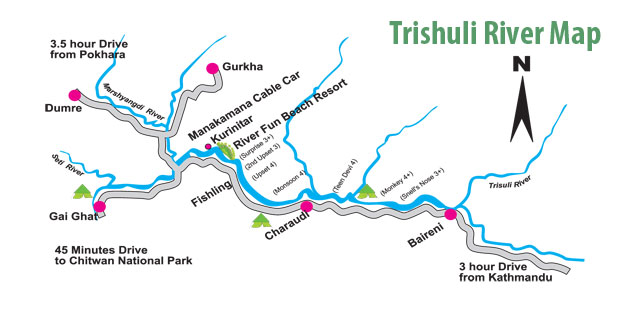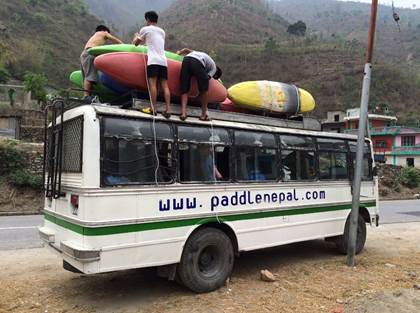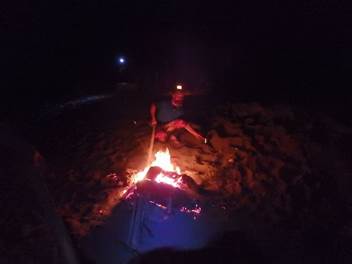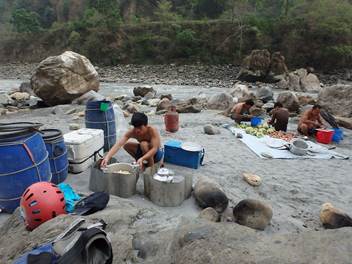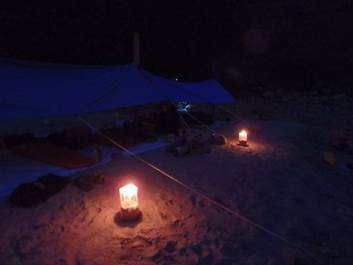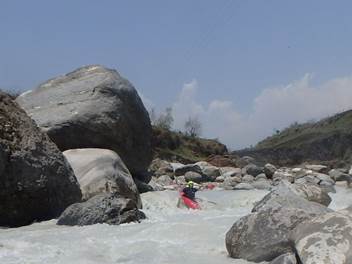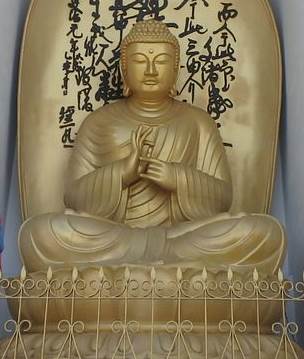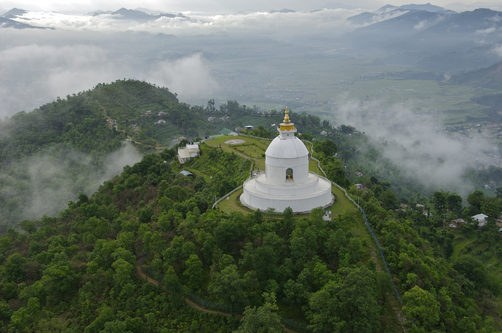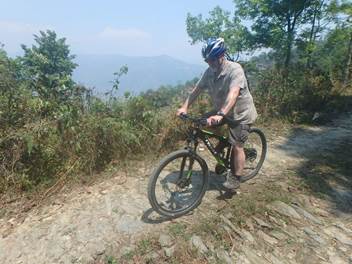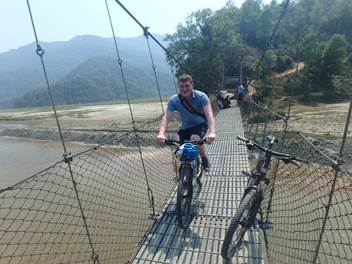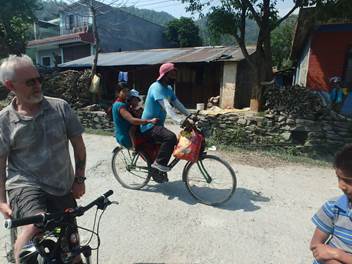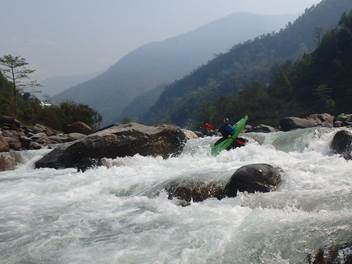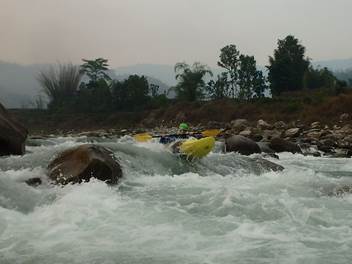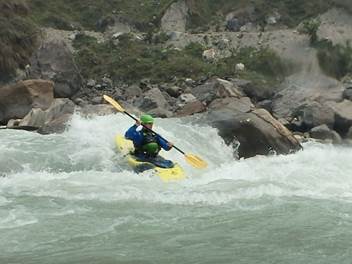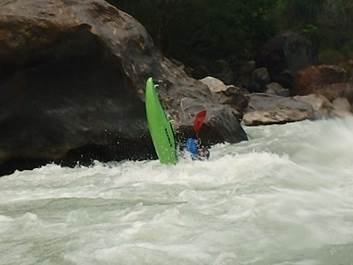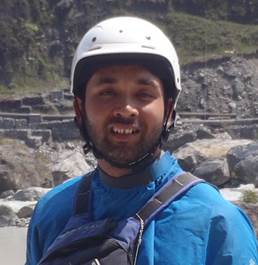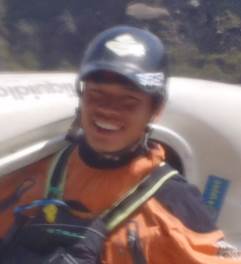|
|
|
|
|
News items or reports on club activities should be sent to website@liverpoolcanoeclub.co.uk |
||
White Water Trip to
Our journey out went like clockwork with 6 of the group flying from Heathrow to Deli (Jet Air) and then on to Kathmandu and 3 taking Qatar Air flights from Birmingham to Dubai and then on to Kathmandu. Graham, Joe and James had arrived first and were eventually met by their Paddle Nepal arranged taxi to be taken to the Hotel (Sacred Valley Hotel). They spent the rest of the day getting their bearings and discovering the many shops of Thamel District.
|
Thamel
is distinguished by its narrow alleys crowded with various shops and vendors.
Commonly sold goods include food, fresh vegetables/fruits, pastries, trekking
gear, walking gear, music, DVDs, handicrafts, souvenirs, woolens, clothes.
Travel agencies, small grocery stores, budget hotels and restaurants also
line the streets. Cars, cycles rickshaws, two-wheelers and taxis ply these
narrow streets alongside hundreds of pedestrians. There are many restaurants in Thamel that serve
traditional and continental cuisine, although prices are significantly higher
than in non-tourist areas. Thamel also acts as the pre-base camp for
mountaineers. It boasts a wide range of mountaineering gear shops, foreign
money exchange booths, mobile phone shops, pubs, clubs, and nightlife along
with the numerous travel agents and guest houses. Thamel is home to a wide
range of the Nepalese population, and serves both entertainment and
employment purposes. Thamel is a
popular tourist district within the capital city of |
|
Later at our hotel we were treated to an evening meal of Dal
Bhat with numerous extra special dishes at the roof top restaurant with several
extra large bottles of beer. The
drinks bill turn out to be me more than the meal and we later found beer was
about £5 per bottle in
White Water Trip to
We were up early at 6:00am for breakfast – Scrambled
egg, ham and toast. Our Toyota
Hiace van arrived to take us through the streets of Kathmandu and on to the
|
|
Our three river guides tying the boats on top of our Paddle Nepal bus which we get to keep for the 2 weeks. |
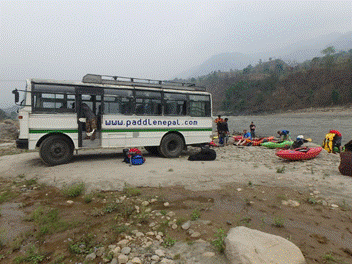 We all gear up and pad out our boats
ready to get on the water. 6 Pipes
is off down the first rapid leaving 3 still sorting their boats. The river is wide – at least 40
metres and the current pours over obstructions in the bed creating many small
waves and rapids. The best rapids
are caused when the river is funnelled through narrows when the Trishuli enters
small gorges.
We all gear up and pad out our boats
ready to get on the water. 6 Pipes
is off down the first rapid leaving 3 still sorting their boats. The river is wide – at least 40
metres and the current pours over obstructions in the bed creating many small
waves and rapids. The best rapids
are caused when the river is funnelled through narrows when the Trishuli enters
small gorges.
The first significant rapid we reach is “Ladies
delight” around grade 3+ where we try to surf and bounce over the big
water. After about 3 km in the
gorge we meet the first of two larger rapids, the first being Gloria. This is enormous compared to water in
the  out into an eddie on river left
followed by several of the group.
We paddle back up the eddie to try and cross and drop into the face of
the first wave which is over head height.
Some reach over the crest with their paddle and get swept downstream
while a few are able to be shot down its face and bounce seemingly out of
control before shooting out the other side.
out into an eddie on river left
followed by several of the group.
We paddle back up the eddie to try and cross and drop into the face of
the first wave which is over head height.
Some reach over the crest with their paddle and get swept downstream
while a few are able to be shot down its face and bounce seemingly out of
control before shooting out the other side.
The second rapid is known as “upset” and regularly flips rafts. The guide book says that it is “infamous and probably the most photographed rapid on the river.” There is a monstrous hole and wave here and we follow Biraz in a line (or get swept by the speed of the river). Most emerge with huge smiles across their faces. Graham fails to roll (he is in a boat that is too small for him) and has a 3 piece! (Boat, paddle and body go in three different directions but are reunited in the eddy below. John (the Silver Fox) is also “Balta” (Nepalese for upside down) but all cheer after his third attempt at a roll is successful.
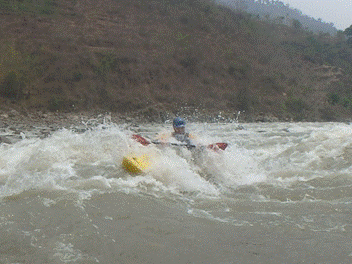 After about another Kilometre we arrive
at an alternative
After about another Kilometre we arrive
at an alternative
The hotel has fantastic views out over the lake at
Polkhara. After cleaning up we head
out into the town to explore and find a good restaurant. Roy and Graham buy some curtains to wear
as trousers; we have to drag
White Water Trip to
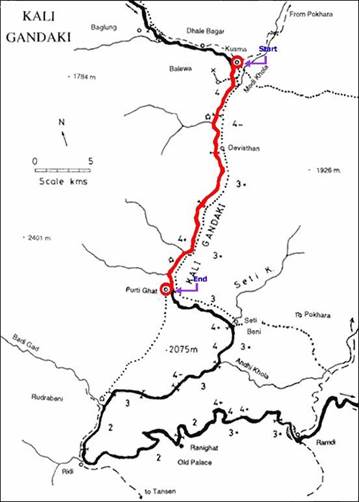
The Kali Gandaki is one of the famous names of Himalayan
Rivers, rising in Mustang in 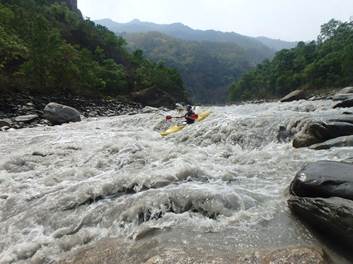 Andhi Khola. This is a fantastic river for non-stop
play action, although there are some holes on the river that you wouldn’t
want to play in. Expert paddlers would be at home on this river and enjoy and
exhaust themselves playing on the waves.
Aspiring and confident intermediates would find this an enjoyable and
fulfilling expedition.
Andhi Khola. This is a fantastic river for non-stop
play action, although there are some holes on the river that you wouldn’t
want to play in. Expert paddlers would be at home on this river and enjoy and
exhaust themselves playing on the waves.
Aspiring and confident intermediates would find this an enjoyable and
fulfilling expedition.
After a 3 hour bumpy and dusty bus ride we arrived at our access point at Baglung. From here there was about 2km of fast flowing grey water indicating the origins of the Kali Gandaki as glacial melt water. After a little while we came across the first hard rapid of the day, Little Brother. This should always be scouted from the bank as often the rapid changes with the seasons. There looked to be a clear line down through with a couple of larger stoppers and a rock / hole on the right at the bottom. We watched as Biraj Grg (Biraz), our guide paddled to show us the line. 6 Pipes did not bother with this and returned to his boat to paddle down straight after Biraz. This was clearly a mistake as although looking very cool in his shades he eddied out and then took a completely different line falling sideways into the first stopper. Over he went, struggled with his roll which took several attempts and by this time had been pushed over onto the right hand side. His cool shades had been lost to the might Gandaki. Everyone else paddled down in style and made the rapid look easy.
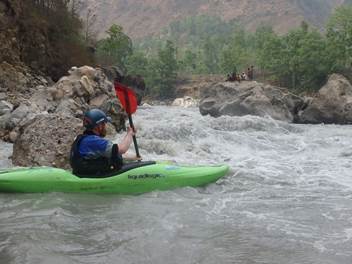 After a short distance we landed on the
river right to scout “big brother”. This is where the rivers main flow
hammers into some massive rocks and you have to break out river left to miss an
enormous hole. This time we all
learned our lesson and watched as Biraz showed us the line. We all returned to our kayaks to paddle
the rapid. John (the silver fox)
struggled to see the line and was Balta (upside down) in the middle of a
massive wave train. His roll failed
him but he kept trying two, three times.
The power of the river was propelling him toward the massive hole on
river right. Fortunately he missed
this by scraping down the rocks on extreme river right and was swept over the
shoulder of the hole and out to safety.
He had been sucked out of his kayak by the power of the water and says
that he never pulled his deck. His
kayak was swiftly emptied in the eddy
After a short distance we landed on the
river right to scout “big brother”. This is where the rivers main flow
hammers into some massive rocks and you have to break out river left to miss an
enormous hole. This time we all
learned our lesson and watched as Biraz showed us the line. We all returned to our kayaks to paddle
the rapid. John (the silver fox)
struggled to see the line and was Balta (upside down) in the middle of a
massive wave train. His roll failed
him but he kept trying two, three times.
The power of the river was propelling him toward the massive hole on
river right. Fortunately he missed
this by scraping down the rocks on extreme river right and was swept over the
shoulder of the hole and out to safety.
He had been sucked out of his kayak by the power of the water and says
that he never pulled his deck. His
kayak was swiftly emptied in the eddy  and we all pointed out how lucky he had
been.
and we all pointed out how lucky he had
been.
The group then paddled down some excellent big water that proved excellent for playing in holes and waves. We were really enjoying the river and getting used to size of the water. Still in a steep gorge we spotted several eagles flying high overhead. The river mellows a little before eventually meeting the Modi Khola. There is a very high suspension foot bridge marks this point. The Kali Gandaki is a very holy river and often confluences are used for cremations. We made for a small beach a few hundred metres down from the Modi Khola and set up camp with the Monkeys.
Our support raft was unloaded and we set up camp fairly quickly. The skies were darkening and far in the distance we heard the rumble of thunder. Fairly soon strong winds were blowing strongly and Kurt’s tent was being blown over. Sand was everywhere but as darkness fell the temperatures stared to cool and winds ceased. Fire Salgie (Roy McHale) had made a large fire from drift wood and we settled down to an excellent meal cooked by our support crew.
|
|
|
|
White Water Trip to
This morning we woke to a great sun rise. Most had a great nights sleep on the
sand. Over breakfast we discussed
the previous days fun and just marvelled in our surroundings. The rafters have a very 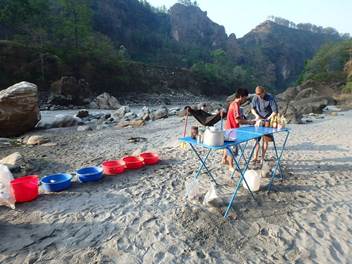 organised system for cleanliness. Everything has to be washed to ensure
that no cross contamination occurs.
Buckets of freshwater are lined up along the flow of the river. Hands are washed using a small pouring
jug with medicated soap ensuring that water is poured over your hands and not
back into the clean water. Dishes
are rinsed, then washed with soap and cloth and then rinsed three times in
progressively cleaner water.
organised system for cleanliness. Everything has to be washed to ensure
that no cross contamination occurs.
Buckets of freshwater are lined up along the flow of the river. Hands are washed using a small pouring
jug with medicated soap ensuring that water is poured over your hands and not
back into the clean water. Dishes
are rinsed, then washed with soap and cloth and then rinsed three times in
progressively cleaner water.
A camp toilet was set up at the far end of the beach. A helmet on top of a paddle
signified that it was free. There
was a square of cloth around 4 rafting paddles with a pit dug in the sand. Used toilet paper was placed in a
plastic bag for later disposal.
Once used you placed a thin layer of sand placed on top to keep things
clean relatively smell free.
This system worked extremely well until 3 piece (Graham) used one of the
plastic bags to place his poo neatly in.
We think the talk of running the
Once the shelters and tents were all packed up and placed onto the raft we headed off down river. The first rapid just below the campsite was aptly named “good morning rapid” and the large waves breaking over us washed those sleepy tears away. We continued down river enjoying the size of water, mostly large grade 3 with many surf waves and wave trains. Before long we were all swept down a large rapid called “Rafters Refund”. Those at the front followed Beraz`s line over the double drop. Progressively the line of 12 crept closer and closer to the shoulder of the massive hole at the bottom just before the house sized boulder. John was the first to be stopped in the hole followed by Keith who was backward surfed and then reverse looped. The remaining paddlers paddled hard to miss the carnage but Stuart went for the left shoulder. As I rolled up I saw the back of his boat. As Keith and John emerged from the hole to be swept downstream Stuart was now pinned against the large boulder holding on to a tree at about neck height. I called for the others to try and help but realistically there was little way anyone could get to the midstream boulder from the bank.
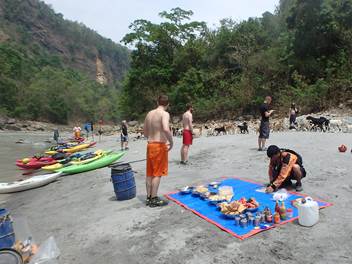
After about 20 seconds Stuart had decided to pull his deck
in case he became trapped; the boat filled with water and sank lower and he
decided to let go and boat with him still in it floated free and downstream
where he was reunited with his paddle.
This was a wakeup call for all. We continued downstream, often
turning back to glance at the
After a few more hours we came to a sandy beach and broke out
the lunch. There was another raft
just along from the beach which had a small fresh water stream. Lunch 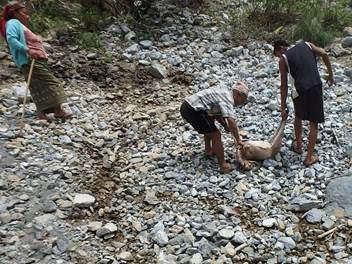 consisted of coleslaw (made in a bag
which amazed
consisted of coleslaw (made in a bag
which amazed
A group of local villagers were herding their goats along
the beach when there was a commotion and much shouting in Nepalese. Tiger, tiger was the call from the
other group everyone pointed their cameras towards the action. I seems that a large cat had attacked
and killed one of the goats at the back of the beach but had been frighten off
but the goat herders. The elderly
lady in charge of the herd took out her smart phone and called the
“Sangie” (boss). After
a few minutes he arrived and dead goat was taken from the undergrowth. This was a significant loss for
the villagers but least they had the remains of the goat. It was most likely an attack from
a leopard as we were informed that there were no tigers in
We headed off downstream but soon came to a bend on the
river with a large cave with many bats inside. We paddled inside to see hundreds of the
furry winged creatures hanging from the ceiling. A little further along we came across
several riverside cremations. It is
the tradition in
As we made our way downstream we took many more photographs before eventually arriving at our campsite. This was a 3 star site, with a visiting bar. A local entrepreneur carried his woven basket down to our camping beach and set up a stall of beer and vodka. When he discovered that 3 of our party did not drink he took out his smart phone and rang up to valley top for James’s order of Coke and Sprite. Within 30 minutes this was delivered onsite but John and Roy had already purchased all the bottles of beer (apparently for later!).
As we set up the tarps for the evening’s camp we were
watched by many of the local children.
After the evening meal
Later that evening we learned how to catch some of the
hundreds of fireflies that drifted around the campsite and debated over the
constellations’ above. We had
lanterns lighting up the camp which were made from clear plastic bags half filled
with sand with a candle placed within.
This all added to ambience. More
Photos…..
|
|
|
|
White Water Trip to
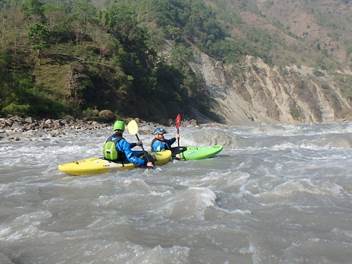 After a very lazy get up and a fantastic
river side breakfast we packed up the raft and set off downstream. The valley opened up a little and the
After a very lazy get up and a fantastic
river side breakfast we packed up the raft and set off downstream. The valley opened up a little and the  river gradually mellowed. Numerous warm waterfalls fell from the
valley sides. Our trainee river
guide swapped into a kayak for this section giving Biraz a turn in the
raft. Unseen by most he swam in the
warm water after failing one of his practice rolls. After a while we pass the remote
river gradually mellowed. Numerous warm waterfalls fell from the
valley sides. Our trainee river
guide swapped into a kayak for this section giving Biraz a turn in the
raft. Unseen by most he swam in the
warm water after failing one of his practice rolls. After a while we pass the remote
After a short while we chase bright blue kingfishers down
the valley side as we enter the “dog water” which forms the lake
before the dam and our get out at Andi Khola. When paddling across the lake we found a
group fishing from a traditional wooden boat – they showed us their catch
– five large fish.
Where the relatively small
 White Water Trip to
White Water Trip to
So today was the river Seti Khola, a continuous grade 3 with some grade 4.
The river itself is a funny colour as it is very silty and a milky colour from
all the glacial rock ground up from high in the 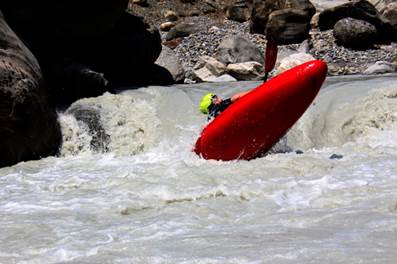 large house sized boulders and rocks.
large house sized boulders and rocks.
The put in was easy enough at a metal bridge with a rough track leading down halfway to the river. The river was technical, eddy hopping as we went down.
There as only two features which really needed scouting. Unfortunately we did not bother with the first one which was a small drop with a boof to the left needed to clear the stopper and large house sized boulder on river right.
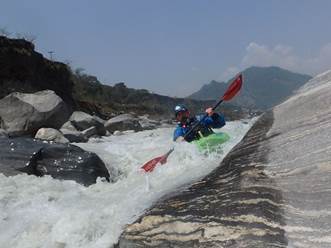 Raju had gone first as this is an ideal
place to take photos. We all made
it over with different degrees of style and then came Stuart. He was aiming too far right and dropped
in rather than boofing. He back
looped skywards and was pushed against the large boulder and eventually swam
out of the turmoil. He had a small cut to his lip but was soon reunited with
his boat. It made for a good
photograph though.
Raju had gone first as this is an ideal
place to take photos. We all made
it over with different degrees of style and then came Stuart. He was aiming too far right and dropped
in rather than boofing. He back
looped skywards and was pushed against the large boulder and eventually swam
out of the turmoil. He had a small cut to his lip but was soon reunited with
his boat. It made for a good
photograph though.
Having learned our lesson we got out and looked at the second rapid. This has a technical run in and snake around large rocks before emerging into a narrow gorge.
After these two rapids the run down to the get out is good grade 3 and fairly continuous.
A great day in an unbelievable country. No rolls, no swims today for me J John (Mamma) Cooke More Photos…..
|
|
|
|
White Water Trip to
|
|
|
|
Gautama Buddha, also known as Siddhārtha Gautama, Shakyamuni Buddha or simply the Buddha, was an ascetic (śramaṇa) and sage on whose teachings Buddhism was founded. He is believed to have lived and taught mostly in the eastern part of the Indian subcontinent sometime between the sixth and fourth centuries. |
|
6 Pipes (Joe Sheppard) after being disappointed that we could not squeeze in another river in the afternoon cam up with the idea of visiting the white domed Peace Pagoda that overlooks our hotel and Phewa Lake. We walked along the beach to the pontoons that hired wooden fishing boats. We negotiated two boats for the 9 of us. We had to pay for a life jacket each but proudly informed the guys that we were all kayakers so everything would be ok. Well it wasn’t, it was clear that our open boat skills were extremely lacking. Everyone looked on as we went round in circles, totally uncoordinated. Somehow we made it across to the restaurant on the other side where we were to moor our craft and hand in the lifejackets and paddles for safe keeping.
The trek up to the top was gruelling to say the least,  step after step, was it ever going to
end? The actual Peach Pagoda was
impressive to say the least and we spent some time at the top looking around
and taking photographs. We
respected the rules (shoes off and silence) but he single security guard at the
top had a difficult time with several visiting Indian tourists and we observed
him blow his whistle several times at some less respectful visitors.
step after step, was it ever going to
end? The actual Peach Pagoda was
impressive to say the least and we spent some time at the top looking around
and taking photographs. We
respected the rules (shoes off and silence) but he single security guard at the
top had a difficult time with several visiting Indian tourists and we observed
him blow his whistle several times at some less respectful visitors.
We then headed over to the café for some cold drinks before making the climb back down which was a lot easier than the climb up. Someone suggested that the first to get to the boats could take one and leave the other for the rest. Some how Kac Kac Keith and Ben Gunn were left on the beach supping beer and coke while the three Gibbons were going round in circles trying to get the boat back to shore to pick up the two waiting travellers. After some discussion of where our departure point was we finally made it back in one piece, but not before our open boating skills had taken a severe dent.
|
Besides being
an impressive sight in itself, the shrine is a vantage point which offers
spectacular views of the Standing on
top of the Ananda hill, Shanti Stupa adds more beauty to There are
many trails for hiking. One of the popular and adventurous hiking trails is
by crossing the |
White Water Trip to
Today was booked as a relaxing day off for people to do as they pleased, five of us hired mountain bikes and split into two groups.
Roy and David choose one route while Keith, James and John
took the option of a longer but supposedly easier one. This involved riding
around the lake via the Peace Pagoda (see 8th of April). so off we went heading out of town early
so as to beat the rush hour traffic and heat which is unbelievable. We headed north east out of Pokhara and
then take a small road leading up to the 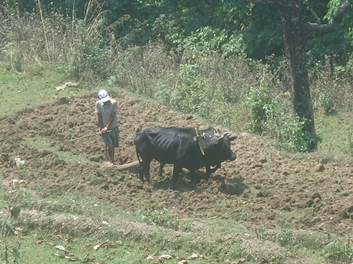 the man in the shop said it was an easy
pleasant ride. By the time we got
to the top it was becoming clear it was anything but easy. We pulled into the
café and the first litre of water was consumed.
the man in the shop said it was an easy
pleasant ride. By the time we got
to the top it was becoming clear it was anything but easy. We pulled into the
café and the first litre of water was consumed.
Back on the bikes; the hills were endless providing some fantastic views over the lake with impressive mountains as the back drop. The downhill sections were superb, long, steep and winding; a mix of dirt, grass and stone. We passed many small farms with Nepalese farmers planting the many terraces for the last of the dry summer season. Two water buffalo were pulling a traditional wooded plough.
Our route took us out and around the lake passing through
villages that showed us the rural
Further down the road we pulled on to a grassy area where the paragliders come into land and watched as they hovered in the sky above us. By now it was way passed lunch time and we headed for a café to get some local food. A lovely lakeside setting and some really nice food and a drink (Momo`s and special fried rice). It was only a short hop back to town and off we went riding along what can only be described as tracks not roads.
Back at the shop the bikes were returned all safe and sound, eight and a half hours it had taken us, about four litres of water each and the only word to descibe the day, BRUTAL
John Cooke More
Photos……
|
|
|
|
White Water Trip to
Joe and Graham went Paragliding and returned!
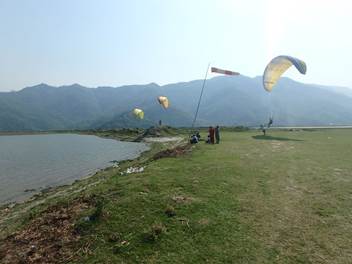
Grumpy1 and Grumpy 2
White Water Trip to
Just returned from my trip around Pokhara on a 500cc Royal Enfield. One off the bucket list (sorry Helen but the voices made me do it.)
|
|
|
|
Stuart Toulson More
Photos……
 White Water Trip to
White Water Trip to
We arrived at our put in after about 2 hours of travelling
along very narrow and winding roads with an almost vertical drop down into the
Our three guides (Raju, Biraj, and Naresh), who we had now got to know very well knew it was Joe (6 pipes) Sheppard’s birthday and had got a special cake for him. We interrupted the briefing to present it to him and slices were cut for all to enjoy. A final pack of the boats; we all had sleeping bags, spare clothes, essentials and a couple of tarps packed into dry bags in the back of the kayaks. They were noticeably heavier and mostly stern heavy. We were to paddle with a small, narrow river approach, eddie hopping all the way down.

Let the nightmare begin !
So today is the start of our over-night self supported trip
down the Madi Khola, described in the guide book as a class four, shallow
As we continued down the river a lapse in concentration and some lazy paddling put me in a hole from which there was no escape. I pulled the deck and came out the boat. Some people thought I was standing up but this was just the power of the water holding me aloft in the foam pile.
Further down the river and again not paying attention I got pushed against a large rock, tipped over and while setting up for a roll, hit a rock with my shoulder. I instantly knew I had done some damage and held my shoulder to support it. After a rescue and a bit further down the river I was upside down again and rolled up in a lot of pain, this was getting serious. The rest of the group got me down to the overnight stop but we had to paddle again tomorrow. John Cooke More Photos….
|
|
|
|
After a full day of 6 hours paddling we stopped on a small
sandy beach opposite the small town of  across the suspension bridge and into
the old town. This traditional
Nepalese farming village was extremely rural in character and we were
across the suspension bridge and into
the old town. This traditional
Nepalese farming village was extremely rural in character and we were 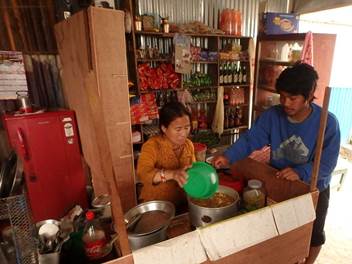 welcomed with the traditional call of
“Nameste”. After
looking around we descended to the riverside restaurant where we welcomed
warmly by he proprietor and provided with Chai Tea (Piping Hot, Sugary and
milky tea which was a favourite of the region).
welcomed with the traditional call of
“Nameste”. After
looking around we descended to the riverside restaurant where we welcomed
warmly by he proprietor and provided with Chai Tea (Piping Hot, Sugary and
milky tea which was a favourite of the region).
In the fading light there was a cremation taking place on the river bank just below the village. This the traditional method of dealing with the dead in this region and involves a hot fire on the bank of the river and the ashes and bones being swept away in the summer Monsoon floods.
The evening meal was prepared – spicy noodle soup which was excellent followed by our staple of Dhal Bhaat. There was one solar lamp to cook by and we had candles on the tables. After several rounds of drinks to celebrate the birthday boy we eventually left the café to kip under one of the two tarps.
We awoke early the next morning and packed up before heading over to the riverside again for a breakfast of two boiled eggs and Aaloo (Potatoes)
White Water Trip to
Early morning and off we went but it was a lower grade and a bucket full of pain killers overnight was enough to get me through it. I had decided to take the next day off to give my shoulder a rest and as we were paddling again for two days it meant I could still do some of the Marsyandi.
White Water Trip to
Following
our long journey from the Madi Khola, we arrived at sunset at what was to be
our home for the next two nights.
We would be staying in the grounds of a small school that was situated
next the river. We quickly de bussed and arranged out
kit ready for overnight stay, we were to sleep the night in what looked like a
roofed open sided concrete
platform.
We quickly de bussed and arranged out
kit ready for overnight stay, we were to sleep the night in what looked like a
roofed open sided concrete
platform.
Once
it was dark we walked to the local village to sample the delights of the
"Goat cafe" a single story building, to the left was the kitchen room
, to the right was the dining area with two tables and a bed. In the rear room lived the goats, Roy (
the goat wrangler ) Mchale must have thought that they looked lonely so with a
series of whistles that are known only to
Following our meal of Daal Bhat, we walked back using the head torches to locate our sleeping platform. Our alarm call was the local children who at six o clock had their first game of football against our sleeping shelter, we did think about challenging them to a game, however they looked too good.
Once
up and packed we breakfasted at the Goat cafe, loaded the bus and headed for
the get in. The guide book states
that the road to the get in used to be named "death ride from hell"
it certainly has its share of sheer drops, with a few cheeky moments when
passing vehicles forced our bus closer to the edge. In
As this was to be an empty boat day we quickly loaded at the get in, eager to start paddling. The river is wide and very powerful with churning grey water and massive boulders. Constant grade 4 or 4+.
Soon falling into a steady rhythm of keeping enough distance between paddlers that you could still see the correct course between the many rocks set by the guide, and not too close in case the paddler in front got into trouble and you needed to avoid them.
The
hours rolled by so quickly, it was sometimes hard for me to focus on tackling
the section in hand when the scenery was so amazing, it was no river to loose
your game face on. I tackled one section, broke out and looked up stream to see
It was a very long day my whole body ached from the constant excursion, so with tired limbs we made the half way point and the get out We had defiantly earned a cold drink and some warm Daal Bhat. What a fantastic day on the " raging river "
Stuart Toulson
More
Photos...
|
|
|
|
White Water Trip to
After an early rise we headed up the hill to the small village for our breakfast. The aroma was not very pleasant however the food was good, egg omelette with fried potatoes. Once we had our breakfast it was back down the hill to get ready for the river. The get on was just down the track from the school from where we had been staying on the playing field.
As we set off down river at first the river offered up fairly technical rapids. One noticeable rapid unfortunately catching out our guide, Raju. In the guide book the rapid is described as having a house rock in the middle which creates a terminal hole in high water. However for us the hole was not terminal just very sticky and somewhere none of us wanted to be. The hole had him firstly side surfing, then upside down and finally out of his boat after a couple of failed rolled attempts. At this point though it would only be fair to say that his unfortunate predicament came about due to seeing Ben Gunn making down cleanly. As on one the previous days he had tweaked his shoulder so not really a place to be when carrying an injury.
So once he was swimming the boat went free but he was being beginning to be sucked back into the hole. Fortunately Kurt was there and was able to get close enough to present his bow in which he was able to grab hold. After getting away from the hole he was ferried over to the bank to return him to his boat. After a quick breather he was back in his boat and we jam jam on down the rest of the river where the rapids eased to make a comfortable finish to the paddle.
David Brockway
White Water Trip to
After we had completed the Lower Marsyandi we embarked on
the bus journey across to the East region of
The next morning following a relatively late breakfast it was back on the bus for a short 1.5 hour journey to the put in for the Belephi Khola which is one of the smaller tributaries to the Sun Kosi which is the major river of the region. At first the bus followed the main road with the Sun Kosi river flowing on our right side we then came to the confluence of the Belephi and turned left up a much narrower side road which wound its way up a steep sided valley. Various little settlements were perched along the route, most of which just consisted of couple of the roughly built corrugated tin and brick shacks which the locals use as houses and animal shelters. The animal shelters usually housing a lone cow or water buffalo with chickens and goats allowed to seemingly roam free around the settlements finding whatever food they can on the road and valley sides. Every now and then we passed small villages which contained local open fronted shops selling various brightly coloured packaged goods.
It was just after one of these villages that as be drove around a bend we came to a road block that had been caused by a small land slip a JCB was already clearing the blockage by filling a large tipper truck with the slipped earth. Whilst the JCB was clearing the road a small traffic jamb was created and the JCB had to widen the road by digging out an embankment so the oncoming traffic could pass each other with inches to spare. We were told by the main guide on the trip Raju that the valley had suffered quite badly in the earthquake that hit Nepal 12 months earlier and there was evidence of structural damage to lots of building we passed on the way up the valley on the opposite site of the river you could also see were massage sections of the mountain side had slipped down towards the river.
We eventually got to the get in of the river which in comparison with the other Rivers we had kayaked so far on the trip had much better water quality and instead of the grey silt colour the water of rivers such as the Kali Gandaki and Upper Seti the water of the Belephi were blue and the river ran through a relatively unspoilt valley. In the white water Nepal guide book the river is described as steep but friendly and is classed as 4- boulder garden run this description is pretty accurate but the guide book grades the rivers at November levels which are higher so I found the river to be a fun grade 3+ with the occasional harder rapid one of which was a narrow constriction through huge boulders.
At times the sides of the valley were heavy with vegetation with monkeys climbing through the trees and at times it felt as though we were kayaking through some remote jungle valley this illusion didn’t last for long though as we descended the settlements we had passed on our way up became visible and there were gangs of local children swimming in the river. The rapids were pretty continual and we eventually we came to the confluence of the Sun Kosi and then continued down the larger river to our campsite playing on the waves of the larger river as we went.
Roy McHale
White Water Trip to
The Team
|
|
|
|
|
|
Raju |
Biraj Grg (Biraz) |
Naresh Grg (Norris) |
|
|
|
|
|
|
|
Mamma (John) |
Botese (Son) (Joe) |
Kac Kac (Keith) |
(Leslie or Banza, Ben Gunn, 1 Pack,) Roy McHale |
|
|
|
|
|
|
|
|
|
|



